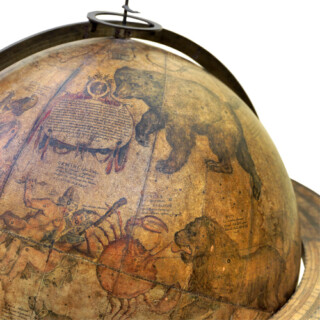Saxton’s seminal Atlas of England and Wales in full original colour
[An Atlas of England and Wales].
[London,
Christopher Saxton,
1579].
First Edition. Folio (415 by 300mm), engraved title-page showing Queen Elizabeth as patroness of Astronomy and Geography, attributed to Remy Hogenberg, engraved plate with coat-of-arms of Elizabeth I from John Norden's 'Speculum Britanniae' tipped-in, double-page engraved plate shown coats of arms and table of counties in manuscript, engraved plate of a table of counties, 35 engraved maps (all double-page, except the map of Yorkshire on two sheets and folding), after Saxton by Hogenberg, Lanaert Terwoot, Cornelius de Hooghe, Augustine Ryther, Francis Scatter, and Nicolas Reynolds, all maps and plates with fine original full-wash colour, with title heightened in gold, map of Hertfordshire trimmed to the neat line along the top edge and with lower corners renewed and some image in facsimile, map of Yorkshire with expertly closed tears, one or two other marginal repairs, some light marginal soiling, copious manuscript notes to upper pastedown and front endpapers, extra illustrated with maps of Middlesex, London, and Westminster from John Norden's 'Speculum Britanniae' tipped-in, plates from Simmons 'A Direction for the English Traviller', pasted to verso of maps, 'Table of Multiplication' by Roger Lestrange, pasted to lower pastedown, original blind stamped panelled calf, rebacked.
11724
notes:
One of the earliest national surveys of any kind and the first uniformly conceived cartographic survey of England and Wales.
Dubbed "the father of English cartography" (Skelton), little is known about Saxton's personal life. Born in Yorkshire between 1542 and 1544, his yeoman family were probably clothiers and farmers. It is likely that Saxton was apprenticed in cartographic draughtsmanship and surveying to John Rudd, Vicar of Dewsbury (1554-1570) and Rector of...
Dubbed "the father of English cartography" (Skelton), little is known about Saxton's personal life. Born in Yorkshire between 1542 and 1544, his yeoman family were probably clothiers and farmers. It is likely that Saxton was apprenticed in cartographic draughtsmanship and surveying to John Rudd, Vicar of Dewsbury (1554-1570) and Rector of...
bibliography:
Chubb I; Evans and Lawrence, pp.9-43; Skelton 1; Shirley, British Library, T.SAX-1b.
provenance:
Early ownership inscription of William Watson beneath Norden's dedication, and copious notes and tables in his hand on the front endpapers dated 1674.







![[SAXTON, Christopher] [An Atlas of England and Wales].](https://omega.crouchrarebooks.com/wp-content/uploads/2025/03/11724_1H.jpg)
![[SAXTON, Christopher] [An Atlas of England and Wales].](https://omega.crouchrarebooks.com/wp-content/uploads/2025/03/11724_2H.jpg)
![[SAXTON, Christopher] [An Atlas of England and Wales].](https://omega.crouchrarebooks.com/wp-content/uploads/2025/03/11724_3H.jpg)
